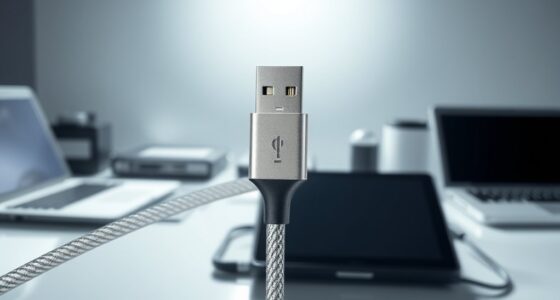AI at the edge with smart cameras processes facial recognition and sensor data locally, ensuring faster responses and reducing latency. By encrypting data right at the source, it keeps sensitive information secure and limits exposure during transmission. This approach enhances privacy by default, as less data travels over networks and personal details are protected throughout their lifecycle. If you keep exploring, you’ll discover how these devices balance security, speed, and privacy seamlessly.
Key Takeaways
- Edge AI enables real-time facial recognition directly on smart cameras, reducing latency and reliance on cloud processing.
- Data encryption at the source ensures sensitive biometric information remains protected during capture and analysis.
- Local processing minimizes data exposure, enhancing privacy by default and reducing risks of interception or hacking.
- Privacy-focused edge devices support compliance with biometric data regulations while maintaining fast decision-making.
- Combining AI with hardware-based encryption offers secure, instant insights, balancing security, privacy, and operational efficiency.

Have you ever wondered how devices like smart cameras and IoT sensors process data so quickly without relying on cloud servers? The answer lies in edge computing, where data is analyzed directly at the source. This setup allows for real-time responses, reduces latency, and limits the amount of sensitive information sent over networks. When it comes to facial recognition, this means your device can identify or verify individuals instantly without transmitting images to remote servers. Instead, the processing occurs locally, ensuring faster identification and a more seamless experience. But with this power comes the responsibility to protect your privacy. That’s where data encryption plays a vital role. By encrypting data at the point of capture, your smart camera can safeguard sensitive information from potential breaches, even before it leaves the device. This prevents unauthorized access and maintains confidentiality, giving you peace of mind.
Edge devices analyze data locally, encrypting it at the source to ensure privacy and faster, secure facial recognition.
In an edge setup, the focus is on keeping your personal data secure by default. Devices are designed to encrypt data immediately, whether it’s facial recognition data or other sensor inputs, so that only authorized systems can decrypt and interpret the information. This approach minimizes the risk of interception or hacking during transmission. Additionally, many edge devices incorporate hardware-based encryption modules, ensuring that data remains protected even if the device is physically compromised. This is especially important as facial recognition technology becomes more prevalent in security and access control, where sensitive biometric data is involved. With encryption happening at the source, the data stays protected throughout its lifecycle, reducing vulnerabilities. Furthermore, integrating tuning principles from automotive applications like Volkswagen tuning can inspire innovative approaches to optimizing device performance and security features.
Furthermore, processing data locally means fewer points of exposure. Instead of sending unencrypted footage to a cloud for analysis, your device can perform all necessary computations on-site, applying encryption as needed. This not only enhances privacy but also accelerates decision-making—whether it’s unlocking a door or alerting security personnel. As regulations around biometric data tighten, edge devices with built-in encryption and facial recognition capabilities help you stay compliant without sacrificing performance. They’re designed to handle sensitive information responsibly, ensuring privacy by default.
In essence, by combining facial recognition with robust data encryption at the edge, these smart devices empower you to harness AI’s benefits while maintaining control over your privacy. They process and protect data locally, providing instant insights without exposing your personal information to unnecessary risks. This balance of speed, security, and privacy makes edge AI a powerful solution for modern security and convenience needs.
Frequently Asked Questions
How Do Edge AI Cameras Handle Data Encryption?
Edge AI cameras handle data encryption by using strong encryption protocols like AES-256 to secure footage and data before transmission. They automatically encrypt data at rest and during transfer, ensuring privacy compliance. You can trust these cameras to protect sensitive information, as encryption happens seamlessly, preventing unauthorized access. This approach keeps your data safe, respects privacy laws, and maintains security without compromising camera performance or real-time monitoring.
What Are the Cost Implications of Deploying Smart Cameras?
You might think deploying smart cameras is costly, but the truth is, they can save you money long-term. While upfront expenses include hardware, installation, and setup, data storage and maintenance costs are often lower because edge processing reduces bandwidth needs and central server reliance. This setup minimizes ongoing expenses, making smart cameras a cost-effective choice for enhancing security and data management efficiently.
Can Edge AI Cameras Operate Without Internet Connectivity?
Yes, edge AI cameras can operate without internet connectivity. They perform local storage and offline processing, allowing them to analyze footage directly on the device. This means you don’t need a constant connection to the cloud, enhancing privacy and reducing latency. You can rely on these cameras for real-time monitoring, ensuring your security system functions effectively even when internet access is unavailable.
How Do Edge Devices Manage Firmware Updates Securely?
You guarantee edge devices manage firmware updates securely by verifying firmware integrity through cryptographic checks and using update authentication. When updates are received, the device checks digital signatures to confirm authenticity and integrity, preventing tampering or malicious software. This process guarantees that only trusted, verified firmware is installed, maintaining device security and stability even without constant internet access, safeguarding your smart cameras from potential cyber threats.
What Are the Scalability Options for Large Camera Deployments?
You can overcome scalability challenges by adopting flexible deployment strategies like centralized management platforms, which streamline device setup and updates across large camera networks. Using cloud-based solutions allows you to efficiently monitor and control deployments, while edge computing reduces latency and bandwidth issues. Automating firmware updates and employing modular hardware also help scale your camera system seamlessly, ensuring consistent performance without overwhelming your infrastructure.
Conclusion
As you embrace AI at the edge with smart cameras, remember that privacy isn’t just a feature—it’s your shield in a digital world. By prioritizing privacy by default, you’re not just keeping data safe; you’re safeguarding your entire way of life from the relentless march of intrusion. With these technologies, you hold the power to turn the tide, making privacy an unbreakable fortress rather than a fragile illusion. The future’s in your hands—guard it fiercely.










